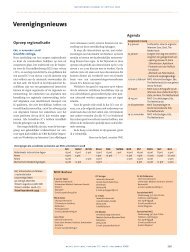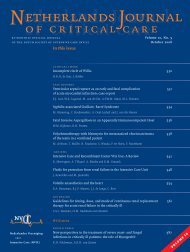Netherlands Journal of Critical Care
Netherlands Journal of Critical Care - NJCC
Netherlands Journal of Critical Care - NJCC
You also want an ePaper? Increase the reach of your titles
YUMPU automatically turns print PDFs into web optimized ePapers that Google loves.
<strong>Netherlands</strong> <strong>Journal</strong> <strong>of</strong> <strong>Critical</strong> <strong>Care</strong><br />
radicals cause single- and double-strand breaks in DNA (scission),<br />
leading to cell-death. The enzyme bleomycine hydrolase deactivates<br />
the drug, but as this enzyme has low activity in the skin and the<br />
lungs, these organs are most susceptible to bleomycin toxicity 2 .<br />
Bleomycin causes activation <strong>of</strong> alveolar macrophages by an unknown<br />
mechanism, resulting in release <strong>of</strong> inflammatory, pr<strong>of</strong>ibrotic<br />
cytokines 7 . Tumour necrosis factor α, transforming growth factor β<br />
and platelet-derived growth factor receptor α are believed to play a<br />
role in formation <strong>of</strong> fibrosis 8 .<br />
Bleomycin interstitial pneumonitis typically (but not exclusively)<br />
develops subacutely during treatment, up to six months afterwards 2 .<br />
Symptoms are nonspecific and include dyspnoea on exertion,<br />
dry cough, tachypnoea and fever. On examination, bibasilar fine<br />
crepitations and hypoxaemia can be noted.<br />
Pulmonary function tests (PFTs) are usually obtained before initiation<br />
<strong>of</strong> bleomycin. Subsequent PFTs are usually performed as clinically<br />
indicated. Diffusing capacity <strong>of</strong> the lung for carbon monoxide (DLCO)<br />
decreases in most patients on bleomycin, but also decreases in patients<br />
receiving non-bleomycin-containing chemotherapy 9 . Deterioration <strong>of</strong><br />
vital capacity (VC) or total lung capacity (TLC) also occurs in patients<br />
on bleomycin and is more specific for BIP 9 .<br />
Diagnosis is by exclusion. Cultures including viral and PCRs on<br />
blood, sputum or broncho-alveolar lavage (BAL) fluid can be done<br />
to rule out infection including opportunistic. Usually empiric<br />
antibiotic treatment is started pending culture results. BAL-fluid<br />
can also be checked for malignant cells.<br />
Chest radiographic findings can be normal, but typically bibasilar<br />
infiltrates, progressing to diffuse alveolar or interstitial consolidation<br />
are found. Rarely, pneumothorax and pneumomediastinum have<br />
been reported in BIP 10 . On high resolution computed tomography<br />
(HRCT) abnormalities may be detected earlier than on plain chest<br />
radiography. HRCT is useful in characterizing the pattern and<br />
distribution <strong>of</strong> abnormalities. HRCT findings vary with underlying<br />
histopathologic pattern (table 2) 11 . Rarely, organizing pneumonia<br />
due to bleomycin presents with subpleural nodules, which should<br />
not be mistaken for progression <strong>of</strong> primary disease.<br />
Lung biopsy can be obtained for histopathological examination,<br />
but findings may be nonspecific. Histopathologic patterns <strong>of</strong><br />
bleomycin-induced lung injury include diffuse alveolar damage<br />
(DAD), nonspecific interstitial pneumonia, cryptogenic organizing<br />
pneumonia (COP) and bronchiolitis obliterans and eosinophilic<br />
pneumonia 12 . DAD, which was also found in our patient, is the<br />
most common form but is nonspecific. It is also the most common<br />
histopathologic pattern seen in ARDS 13 . It is characterized by diffuse<br />
alveolar septal thickening, patchy or diffuse airspace organization<br />
and focal or diffuse hyaline membranes, in the absence <strong>of</strong> signs <strong>of</strong><br />
infection (including viral), granulomas and prominent eosinophils<br />
or neutrophils 14 .<br />
Risk factors for development <strong>of</strong> BIP have been identified (table 3) 2,15 .<br />
A previous history <strong>of</strong> pulmonary disease has not been reported<br />
as a risk factor, but the risk <strong>of</strong> dealing another blow to an already<br />
compromised organ seems obvious.<br />
Table 2. High resolution computed tomography manifestations <strong>of</strong> different<br />
histopathological types associated with bleomycin toxicity 11<br />
Diffuse alveolar damage Bilateral airspace consolidation and ground glass<br />
opacities involving dependent lung regions<br />
Alveolar haemorrhage Extensive bilateral ground glass opacities with or<br />
without superimposed interlobular linear opacities<br />
(‘crazy paving’)<br />
Hypersensitivity<br />
pneumonitis<br />
Nonspecific interstitial<br />
pneumonia<br />
Cryptogenic organizing<br />
pneumonia and<br />
bronchiolitis obliterans<br />
Eosinophilic pneumonia<br />
Bilateral ground glass opacities and/or small poorly<br />
defined centrilobular nodules. Air trapping<br />
Patchy bilateral or diffuse ground glass opacities<br />
with associated reticular opacities. Mainly lower lung<br />
zones and subpleural regions involved<br />
Ground glass opacities in bilateral random<br />
distribution. Airspace consolidation in subpleural or<br />
peribronchial distribution. Rarely solitary nodules<br />
Airspace consolidation and ground glass opacities<br />
in predominantly peripheral distribution, involving<br />
middle and upper lung zones<br />
Table 3. Risk factors for bleomycine pulmonary toxicity 2,15<br />
Age<br />
Renal insufficiency<br />
Smoking<br />
Radiation therapy<br />
High fraction <strong>of</strong> inhaled oxygen<br />
Concurrent use op granulocyte colony stimulating factor<br />
Concurrent use <strong>of</strong> cisplatin<br />
The role <strong>of</strong> high FiO2-administration is controversial. The<br />
pathogenetic mechanism (with a central role for formation <strong>of</strong> free<br />
radicals) suggests a possibly harmful effect <strong>of</strong> high FiO 2<br />
, which<br />
has been confirmed by most studies in animals. In humans, this is<br />
supported by reports <strong>of</strong> patients developing acute respiratory failure<br />
postoperatively after previous treatment with bleomycin. A major<br />
review article in 77 patients who received bleomycin, however, failed<br />
to show a correlation between FiO 2<br />
-restriction and postoperative<br />
pulmonary morbidity or survival 16 . Usual practise is to keep FiO 2<br />
as<br />
low as possible. In hypoxemic patients, oxygen is supplemented as<br />
needed to reach an oxygen saturation <strong>of</strong> 89-92%.<br />
Once BIP has been diagnosed, further bleomycin treatment should<br />
be withheld. Patients can be treated with glucocorticoids (for<br />
example, prednisone 0.75-1 mg/kg day up to 100 mg/day). There are<br />
no controlled studies <strong>of</strong> glucocorticoids, but observational studies<br />
have suggested a beneficial effect 5 . Response may vary according to<br />
histopathological pattern. Further treatment is mainly supportive.<br />
Shortly after we lost our patient, an interesting case report was<br />
published, describing a patient with life-threatening BIP, who was<br />
completely cured with imatinib-mesylate, after steroid treatment<br />
failed 17 .<br />
Our patient was at increased risk <strong>of</strong> bleomycin pulmonary toxicity<br />
due to his age, smoking status and COPD. In retrospect, he had<br />
already showed symptoms <strong>of</strong> BIP after the first two rounds <strong>of</strong><br />
chemotherapy. His symptoms were given clinical attention, but<br />
unfortunately the treating physicians were lured into a false sense <strong>of</strong><br />
28 Neth j crit care – volume 17 – no 1 – february 2013







